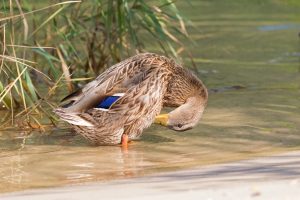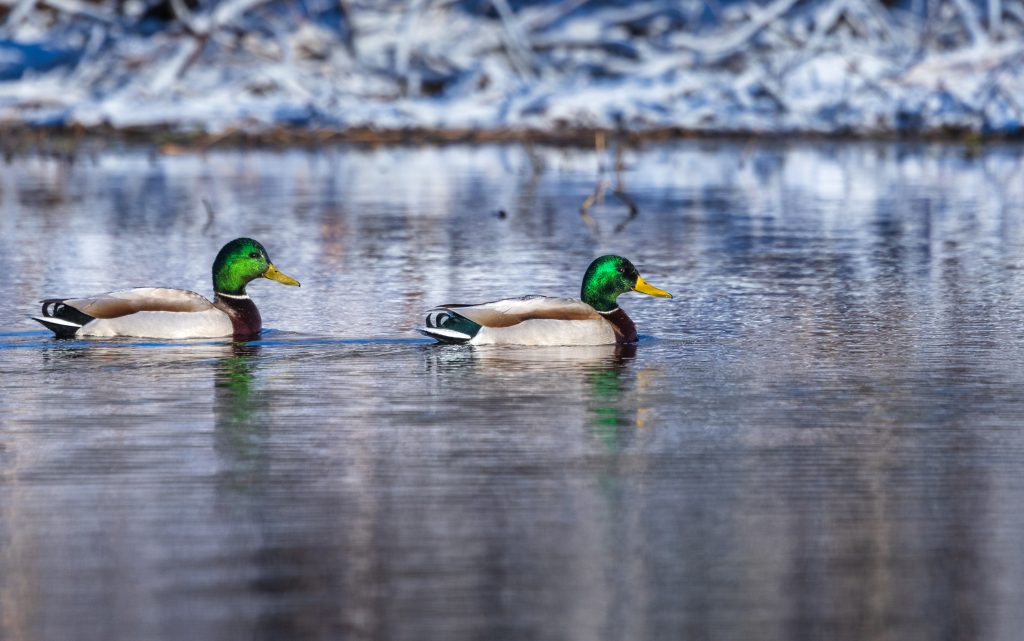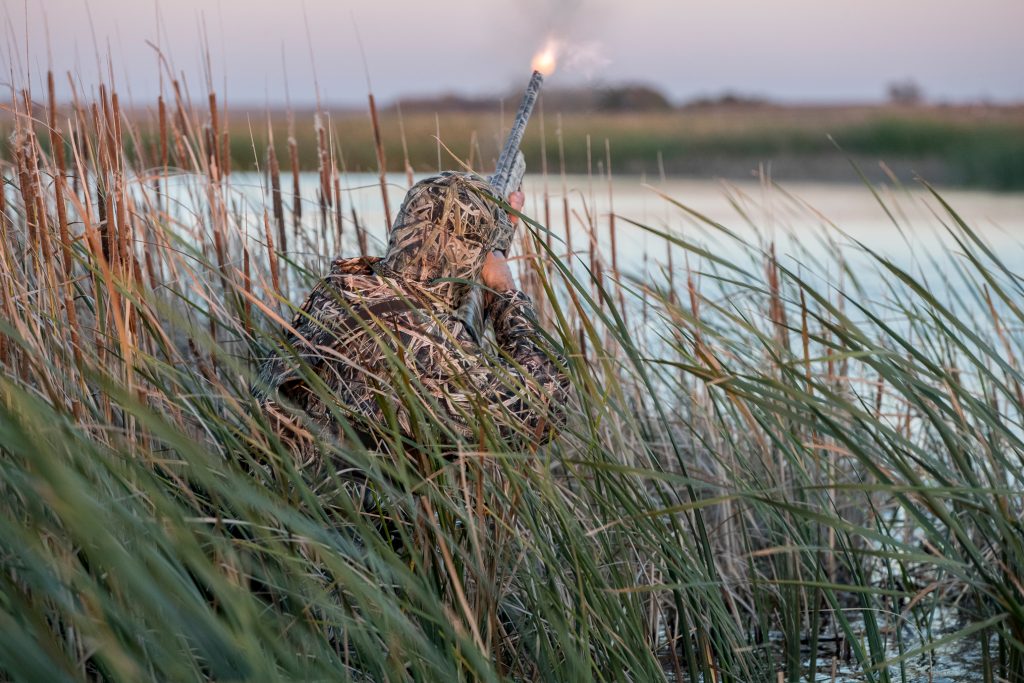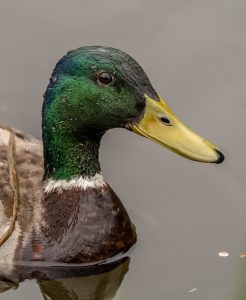Waterfowl have some amazing adaptations for living in and on an aquatic environment. They can withstand wild weather, travel sometimes extraordinary distances and somehow make it through a gauntlet of gunners each fall. Knowing a little more about them can make us better hunters and gamekeepers and if nothing else, give us much greater appreciation for them.
Waterfowl Plumage
We’re all familiar with the expression: “Like water off a duck’s back.” Like many bird species, ducks and geese have a “uropygial” or oil gland on their rump. When not feeding, they’ll spend hours preening, dabbing oil from this gland and meticulously working it into their feathers so that water literally rolls off. This adaptation allows them to live in an aquatic environment while staying relatively dry, and warm.

sasimoto
Sitting on the rocky coastline of Maine our hunting party readied as a brace of buffleheads banked and raced toward our decoys, curious, but showing no signs of slowing. My first shot was behind. The second was dead-on and I saw spent pellets creating a perfect splash ring around the bird, which to my surprise showed no ill effects. The third shot was merely an unanswered prayer.
Next to our spread was a pair of common eiders, flying just as fast but appearing slower due to their much larger size. The practice round on the buffleheads had us prepared and first shots found their mark. My bird tumbled into the sea, quickly righted itself then dove. My partners bounced three times over the wave tops like a flung rock, then vanished into the fourth wave. The ensuing chase took valuable time out of our hunt.
Underneath their contour or body feathers is a layer of fine down feathers, the loose structure of which traps air, helping to insulate against heat loss, and increasing buoyancy. This layer is relatively thin during the nesting season but grows in thicker after the fall molt, adding greater insulation in winter.
Some species, particularly eiders, will pluck their own down feathers to line their nests and help insulate eggs. After the nesting season, people would collect down from nesting colonies and use it to line pillows and jackets. Today we use mostly synthetic fabrics for the same purpose.
While certainly unintended by nature, this heavier layer of fall feathers also sometimes functions as a flak jacket, as many a late-season waterfowler will attest. Though soft and frail on their own, a layer of feathers can absorb a lot of energy before your pellets pass through to flesh and bone, so heavier loads are always advisable later in the season.
Cold Feet
Standing still in waist-deep water in a stand of flooded oak I shivered almost uncontrollably. Despite my neoprene chest waders, heavy fleece mid layer and Merino wool base layer, the icy water seemed to penetrate into my very bones and I wondered how the ducks survived with their naked legs constantly exposed to nearly frozen water and even colder air.
They do so through a process called counter-current heat exchange. Folks experienced in tracking wounded deer should be familiar with the phrase, “A for away (and arteries).” Warm, oxygenated blood flows away from the heart and lungs through arteries, which tend to be deeper in the body cavity. Cold blood travels back to the heart through veins.

Linda Arndt
In some parts of the body, particularly the extremities, arteries and veins run side-by-side, effectively “exchanging” heat and cold. Arterial blood destined for the feet is cooled by venous blood, which in turn is warmed a few degrees. As a result, ducks conserve heat such that just five percent of total body heat escapes through their feet, even when standing on ice. And they can reduce that heat loss by half again simply by standing on one foot and tucking the other up into their feathers. They may also tuck their bill into feathers to further conserve heat, which serves a dual purpose. First, less heat is lost through direct exposure. Second, they’re inhaling warmer air.
Back on the coast of Maine, we spied a thin, black wavering line winging our way over the wave tops – scoters! The birds pitched in outside our decoy spread and just out of range, but slowly swam our way, diving, then reappearing closer. The plan was to wait until they were well in range, then stand up and flush the birds. Down they went and we waited, and waited, and waited. I ran out of breath long before they did and when they finally reappeared the tide had carried them safely out of range.
Sea ducks, and their inland cousins, the divers feed mostly underwater, the latter group diving down to reach aquatic vegetation that their surface dabbling cousins can’t, or at least choose not to. They typically don’t dive too deep as aquatic vegetation thins out after about 20 feet of depth, but may dive deeper for mollusks or fish. Sea ducks, which feed more on mollusks and marine invertebrates typically feed in water 10 to 65 feet deep. Oldsquaw, now referred to by the more politically correct long-tailed ducks can swim down to 200 feet.
The feat seems even more remarkable when one considers what a buoyant body these birds have. However, sea ducks and divers are built differently than dabblers. They have denser bodies, making them relatively heavier, and more compact wings that can be compressed tightly against their bodies for better diving efficiency. That’s why they must skitter across the water in order to gain enough speed and momentum to take flight as opposed to dabblers, which can literally launch off the water. They also glide in at an angle rather than plopping down to land.In addition to their wings, divers also compress their body feathers before diving to further reduce buoyancy. They do have relatively large lungs, which can account for more than 50 percent of their buoyancy, but allows them to linger longer underwater. A typical feeding dive may last 10 to 30 seconds but they can remain underwater for over a minute.
Extra oxygen isn’t the only thing that allows them to do this. They have a high tolerance for asphyxia or lack of oxygen and their bodies can ration that oxygen to sensitive tissues in the central nervous system, shunting it away from other organs and skeletal muscles.
Furthermore, these ducks also experience a phenomenon called the “diving reflex.” When water touches receptors in their nostrils, it triggers organs and muscles to rely on anaerobic (oxygen-free) metabolism. And when they’re done feeding, they simply relax and float to the surface to reduce consumption of remaining oxygen.
Waterfowl Traveling Distances
Another extraordinary feature about waterfowl is the sometimes incredible distances they travel between migration and wintering grounds. While the Arctic tern is the all-time champion at 55,000 miles, Canada geese may migrate 3,000 miles or more and some white geese may travel as much as 6,000 miles between nesting and wintering areas. Like humans, some waterfowl prefer to skip the layovers and take a direct flight. Black brant are the champs for non-stop flight, sometimes covering a journey of roughly 3,000 miles from coastal Alaska to Baja California in under 72 hours.

My state has a split waterfowl season. The first half gives us a shot at local birds and a few early migrants, but the early pressure quickly thins the birds out. The intermission offers a chance for local hotspots to replenish with newcomers that will hopefully hang around long enough for the start of the second half and a new crop of naive birds.
Most waterfowl species prefer staging and refueling at stopovers, but even so they undergo physiological changes. While in flight they’re in a catabolic state and their bodies are breaking down or losing fat and muscle. Once they stop, they enter an anabolic state, replenishing energy stores and gaining fat by gorging. That’s why traditional migration stopover areas with ample food are so important, both on the trip south and then back again.
Even their bodies change depending on situations. While feeding, digestive muscles and organs undergo hypertrophy, becoming enlarged. When sufficient fat levels are achieved, muscles and organs required for sustained flight like the heat and pectoral muscles become enlarged. Then the birds take to wing and the digestive system begins to atrophy.
Waterfowl also employ several strategies for efficient migration. One is flying in the familiar “V” formation. The lead goose does much of the work, allowing followers to draft, much like a race car, and the birds periodically change position to share the workload. Ever wonder why when geese fly in “V” formation one side is longer than the other? Because one side has more geese.
Waterfowl Senses
The sun had just topped the tree line when I heard whistling wings in the distance, then spotted a small flock of dabblers, most likely mallards and blacks, streaking overhead. At my very best highball they banked and turned back, making a wide arc overhead, then seemed to stall when a feeding chuckle coaxed them to make another turn. “One more turn and they’d commit,” I thought… but instead they flared, then picked up speed as they headed away. “What could they possibly have seen?” I wondered. We were well concealed in our blind, and neither me nor my partner had dared move. Then, as he looked up I noticed a glint of sunlight on his glasses.

craig wilson
Waterfowl also possess physical attributes that help them in more mundane and routine activities. While the wild turkey’s vision is legendary, waterfowl are no slouches. They too, see color quite well – far better than humans and into the UV part of the spectrum – making proper camouflage critical to waterfowlers. Like turkeys, their eyes are located on either side of their head, giving them 360-degree panoramic vision with a slight turn of the head. Their eyes also contain muscles that can alter the curvature of the lens and cornea, the latter of which also has a corneal streak, allowing them to see 3 times farther and with more visual acuity than humans. And like deer, they have a higher density of rods, giving them better night vision.
The birds were mere specks in the distance when I threw out a high-ball call that caught their attention and prompted them to turn our way. Still high overhead they circled widely and my partner and I chuckled on our calls. As they banked over the far end of the marsh where another group of hunters was set up, a cacophony of calls that sounded somewhat like a New Year’s Eve celebration erupted from the reeds. The birds flared, shifted into overdrive and soon vanished in the distant sky.
Waterfowl have pretty good hearing too, and use a variety of vocalizations to communicate. Just like turkey hunting, learning the different calls and how and when to apply them can be of great benefit to the hunter. Loud, aggressive calling will get their attention from sometimes great distances, and like turkeys they seem to be able to pinpoint the source. Then it may take a little subtle persuasion to hold their interest and convince them to come closer.
Even their lungs are quite different from ours, which proves beneficial during high-altitude flights. They lack a diaphragm so their lungs don’t expand and contract. Instead, air sacs store and pump air through the stationary lungs, in one direction. This allows them to take in air during exhalation. And because these sacs are controlled by muscles, the more they move (like when in flight) the more air they take in. Meanwhile, an oversized heart helps them fly hundreds of miles in one stint.
Even their wings are aerodynamic marvels. The longer primary feathers provide thrust while the secondary feathers on the trailing edge provide lift. Lateral flight is achieved by moving wings in a figure-eight pattern. Some waterfowl, particularly geese, are adept at “whiffling,” altering body and wing orientation in order to quickly lose altitude. As noted above, geese and puddle ducks then pump furiously to effect a soft landing, while divers and sea ducks glide in on smaller, shorter wings and skid across the water’s surface to a stop.
Difference Waterfowl Species
There are roughly 40 different species of ducks native to North America and while they’re all derived from common ancestors they have diverged to exploit a number of different ecological niches. Some are dabblers, feeding mostly on surface vegetation in relatively shallow water. Others are divers, seeking deeper plants their cousins can’t reach. Some, like sea ducks prefer invertebrates like shellfish and crustaceans. While others, like mergansers feed mostly on fish.
Among and between groups there are specialists. Widgeon (also spelled wigeon) often associate with divers like redheads, canvasbacks and scaup, stealing bits of floating vegetation from their deep-diving cousins. Most ducks nest on the ground but a few, like the wood duck, hooded merganser and bufflehead nest in tree cavities – or man-made nest boxes. Some even practice dump nesting, where several females will deposit their eggs in the nest of another, leaving the unlucky individual to raise several broods. Some species, like scaup and eiders hatch their own broods but later congregate in large groups called creches, leaving the youngsters in the care of a few adults while they go off temporarily to feed, then come back later to take their turn.
These are but a few of the many ways waterfowl have adapted to exploit a variety of habitats, climates and conditions. By knowing what they eat, we learn where to look for them, and what we can provide not only to attract them but help them on their journey. By knowing how they see and hear, we can take steps to conceal ourselves from their keen vision and at least occasionally coax them to come our way. Whether we bring a few home or not, a day on the duck marsh is always time well spent, especially when you know more about your adversary.








